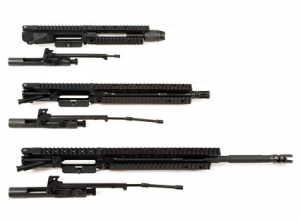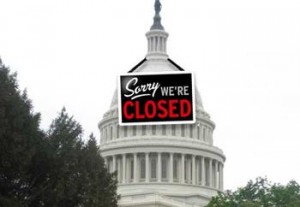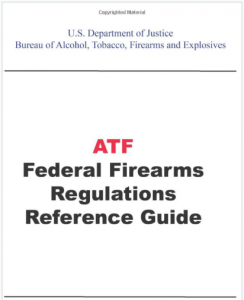 As of last Monday’s Federal Register, we now have the full text of the proposed regulatory changes that the Obama Administration is pushing to close what they are calling the ‘trust loophole’ and it is far worse than I had initially feared.
As of last Monday’s Federal Register, we now have the full text of the proposed regulatory changes that the Obama Administration is pushing to close what they are calling the ‘trust loophole’ and it is far worse than I had initially feared.
I had based my original expectations upon the Petition For Rulemaking (PRM) that the National Firearms Act Trade and Collectors Association (NFATCA) had submitted in 2011 and the proposed rules resulting from that PRM that made appearances in both 2011 and 2012.
While the newest proposed rulemaking gives lip service to the NFATCA PRM, it completely fails to address the key problems that the PRM was hoping to solve while simultaneously creating an entire class of new problems for law-abiding NFA collectors.
This situation has confused experienced collectors and for those just getting started in the NFA world, it is downright mind-boggling. Consequently, the phone has been ringing off the hook as collectors and prospective collectors search for answers.
A typical phone call goes something like this:
Did President Obama issue an executive order eliminating the use of trusts to purchase NFA items?
No! All he did was to throw his weight behind a proposed regulatory change. In order to become effective, it must still go through the regulatory rulemaking process.
What is the regulatory rulemaking process?
It is a process that attempts to interject due process protections into rulemaking by executive branch administrative agencies.
Why do administrative agencies even have the power to pass laws?
They don’t. Under our system of government, Congress passes the laws, the courts interpret the laws, and the executive branch is charged with executing the laws. To accomplish that goal, the executive branch has administrative agencies that promulgate regulations to ‘fill in the gaps’ between the often expansive grant of power in a particular piece of legislation and the specific rules that are needed to effectively execute the legislation in the real world.
How does the regulatory rulemaking process work?
In order to achieve a level of due process that satisfies minimum constitutional requirements, most regulatory changes must go through what is known as a ‘notice and comment’ period during which time the full text of the change is published and the public is allowed to submit comments, both pro and con, on the proposed change. This information is then summarized and theoretically forms the basis for an impartial decision on the merits by the agency (in this case the ATF).
What do you mean by ‘decision on the merits?’
To quote from the Federal Register’s Guide to Rulemaking:
“At the end of the process, the agency must base its reasoning and conclusions on the rulemaking record, consisting of the comments, scientific data, expert opinions, and facts accumulated during the pre‐rule and proposed rule stages.
To move forward with a final rule, the agency must conclude that its proposed solution will help accomplish the goals or solve the problems identified. It must also consider whether alternate solutions would be more effective or cost less.
If the rulemaking record contains persuasive new data or policy arguments, or poses difficult questions or criticisms, the agency may decide to terminate the rulemaking. Or, the agency may decide to continue the rulemaking but change aspects of the rule to reflect these new issues.
If the changes are major, the agency may publish a supplemental proposed rule. If the changes are minor, or a logical outgrowth of the issues and solutions discussed in the proposed rules, the agency may proceed with a final rule.”
Has the ‘notice and comment’ period already started for this proposed regulatory change?
Yes. The ‘notice’ portion occurred on Monday September 9, 2013 when the proposed regulatory change was published in the Federal Register. We are now in the ‘comment’ period which does not end until December 9, 2013.
How does one make a comment on this proposed regulatory change?
The easiest way to comment on the change is to use the Federal eRulemaking Portal. But don’t head over there and start telling them how bad their ideas are just yet. Finish reading this article so you know just how complex the issue is and why this proposed change to ATF regulations will create more problems than it solves.
So if it does become a final rule, when will the change become effective?
The final rule must itself be published in the Federal Register and the rule cannot take effect for at least 30 days after that publication. So … we have until sometime early next year if the ATF is determined to push this through.
Will the proposed change affect existing trusts?
Well … no not really … but yes a little.
No … you will not have to retroactively submit fingerprints, photographs, and CLEO sign-offs for all of the ‘responsible parties’ in your trust if you already have an NFA item or an application pending.
However … once the regulation goes into effect, the next time you submit a Form 1 or Form 4 application you will have to comply with all of the new requirements.
What exactly are those new requirements?
To understand the changes, you must first understand where we are right now.
Current ATF regulations require individual applicants to get sign-off from their local chief law-enforcement officer (CLEO). This is known colloquially as the ‘CLEO Signoff.’
In many jurisdictions, the CLEO will not sign the form which acts as an effective ban on the acquisition.
That’s where the NFA trust comes in. Currently, trust applicants do not need CLEO Sign-off. Nor do they need to submit the fingerprint cards and photographs that individual applicants must submit.
The proposed change wants to do away with this option. It would require that all ‘responsible persons’ of a trust complete the same requirements that individual purchasers must currently complete including the process of securing a CLEO sign off which would subject trust applicants to the same arbitrary bans that CLEOs have been using against individual applicants.
What exactly is a ‘responsible person’ where trusts are concerned
The proposed regulations defines a ‘responsible person’ broadly as “any individual, including any grantor, trustee, [or] beneficiary, … who possesses, directly or indirectly, the power or authority under any trust instrument … or under state law, to receive, possess, ship, transport, deliver, transfer, or otherwise dispose of a firearm for, or on behalf of, the [trust].”
What does all this mean?
If this proposed change becomes a final rule, trusts and corporate entities will no longer offer collectors a way to avoid the de-facto ban instituted by so many CLEOs across the country.
In addition, even in jurisdictions where CLEO sign-off is not a problem, the definition of ‘responsible person’ is overly broad and unworkable. If you have two joint trustees plus four children as beneficiaries, all seven of you will have to complete the application process including CLEO sign-off.
Whoever drafted these regulations either did not understand the full implications of what they were doing … or they knew exactly what they were doing and their actual intention was to eliminate the trust as a vehicle for NFA registration.
So what do we do to stop this?
We need to make our voices heard during the comment period. I will be posting suggested comments in the coming days.
 A client called me today as she was completing her Form 1. She wanted the option to configure multiple uppers on her SBR once she received her approved Form 1 and tax stamp.
A client called me today as she was completing her Form 1. She wanted the option to configure multiple uppers on her SBR once she received her approved Form 1 and tax stamp.
 With lead-times for NFA applications exceeding eight months and rising, I am often asked how to go about checking the status of an application.
With lead-times for NFA applications exceeding eight months and rising, I am often asked how to go about checking the status of an application. I have been contacted by several clients asking whether or not the government shutdown is affecting the processing of Form 1 and Form 4 applications.
I have been contacted by several clients asking whether or not the government shutdown is affecting the processing of Form 1 and Form 4 applications. When Sheriff B.J. Roberts of Hampton Virginia won reelection, he fired a number of employees who had backed his opponent including jailer Daniel Carter.
When Sheriff B.J. Roberts of Hampton Virginia won reelection, he fired a number of employees who had backed his opponent including jailer Daniel Carter. As of last Monday’s Federal Register, we now have the
As of last Monday’s Federal Register, we now have the 



